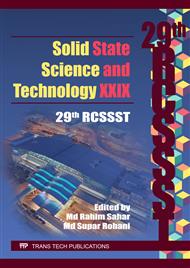p.67
p.72
p.77
p.82
p.87
p.92
p.97
p.102
p.106
Improved Hydrophobicity of Silicon Dioxide Integrated Zinc-Tellurite Glass Surface
Abstract:
Economically viable and maintenance free glass surfaces with improved hydrophobicity are highly demanding in the recent nanotechnology era. Deposition of pollutants and dirt on glass surface that not only causes visual obscurity but also damages the cultural heritages are still to be researched intensely. It is documented that excellent hydrophobic surfaces (with contact angle greater than 90o) can be achieved by controlling the surface wettability, where liquid droplets remain spherical on such surfaces. Selection of materials and the preparation method play a significant role towards such accomplishments. Stirred by this idea, we explored the feasibility of fabricating super-hydrophobic tellurite glass systems by facilely varying the compositions of different constituents. Highly transparent and thermally stable ternary tellurite glass system with chemical composition of (80-x)TeO2 – xSiO2 – 20ZnO, where x = 0.00 to 0.20 mol% are synthesized via conventional melt-quenching method. Samples are characterized using Atomic Force Microscopy (AFM) and contact angle measurements. The impact of SiO2 concentrations variation on the surface roughness, surface energy, and hydrophobic properties are inspected. Glass surface roughness as much as 9.885 nm is attained. The optimal value of water contact angle is discerned to be 101.02° for 0.1 mol% of SiO2 incorporation into the amorphous tellurite host matrix. Besides, the surface energy revealed an inverse proportionality to the water contact angle. This achieved contact angle (greater than 90°) makes this hydrophobic glass surface beneficial for diverse applications. It is established that the present glass composition may be prospective for the development of super-hydrophobic surfaces.
Info:
Periodical:
Pages:
87-91
Citation:
Online since:
October 2017
Authors:
Price:
Сopyright:
© 2017 Trans Tech Publications Ltd. All Rights Reserved
Share:
Citation:


